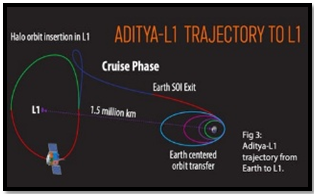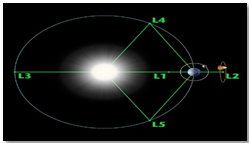ADITYA L1’S CONFIDENT ORBIT INSERTION
Why in the News?
- Aditya L1, India’s solar observatory reached its destination , ,into a halo orbit around Sun-Earth Lagrangian Point L1.
- Launched on September 2, it has covered a distance of 1.5 million km.
Source: Weather.com
About Aditya L1 :
- Launched via : PSLV XL from Satish Dhawan Space Centre in Sriharikota.
- Aims to establish a solar observatory in a halo orbit around the L1 lagrangian point.
- Aditya L1 has 12 thrusters for the final manoeuvre, with periodic orbit maintenance planned every 45 days.
- Aditya L1 has fuel adequacy for over five years.
- Payloads for Solar Examination:
- Carries seven payloads for in-depth Sun observation.
- Includes visible and X-ray spectrometers, a coronagraph, solar wind analyzers, energetic particle detectors, and magnetometers.
- Science Objectives:
- Focus on understanding coronal heating and solar wind acceleration.
- Investigate initiation of Coronal Mass Ejection (CME), solar flares, and near-earth space weather.
- Study coupling and dynamics of the solar atmosphere, along with solar wind distribution and temperature anisotropy.
| About Lagrange Points
Definition: According to NASA , Lagrange Points represent locations in space where objects, once positioned, exhibit a tendency to remain stationary. These points occur when the gravitational forces exerted by two significant masses precisely balance the centripetal force necessary for a smaller object to co-move with them.
· Five positions in space where gravitational forces of two large bodies, like Earth and Sun, create stable points. · Denoted as L1 to L5. · L1 commonly used for solar observatories like Aditya L1. · L2 used for space telescopes and observatories. · L3, L4, and L5, less commonly used, form equilateral triangles with the large bodies, providing stable regions for satellite placement. |

 Source: Weather.com
Source: Weather.com Source: NASA
Source: NASA

